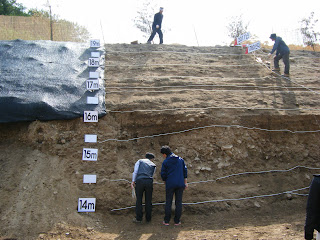Field Trip to GongSanSeong(公山城)
This was my second visit to GongSanSeong.
(for basic information on GongSanSeong,
just refer to the previous post;
I only visited the top during my former fieldtrip to GongSanSeong,
so this time, I headed for the village Seong-an(성안마을)
The photo above was taken in the 1990s.
As you can see, there was a village at that time
but the village is currently changed into an excavation site like this.
Seong-an Village (성안마을) is located on flatland in GongSanSeong.
it has been suspected that there are important relics underground
because there were only a few ancient building sites in GongSanSeong's other regions and the should be more.
The importance of Gongsanseong was already mentioned in the former post.
The view of the excavation site in Seong-an Village
The trial digging on Seong-an Village commenced on 2004.
It was financed by Gongju University Museum.
They have buckled down on this excavation since earlier this year.
A distribution Chart of the Ruins
The excavation team of Gongju University dug six meters more from the stratum of Joseon Dynasty which was seventeen meters below the earth's surface.
After ending the excavation, this site is supposed to be changed into a traditional village for sightseeing.
I just wonder whether the plan will go well,
since if many significant relics are found in there,
the plans will be canceled.
Proof of the war in 660 can be found in a huge pile of arrowheads discovered near the beds of roof tiles.
This is a huge discovery because it shows arrowheads of three different countries(Goguryeo, Baekje, Silla) in the 7th Century.
Take a look at this site where a man is standing.
The most significant relic was discovered there !
This is the relic.
Leather armor from the Baekje period with letters on it.
It is entirely unprecedented in the case of leather armor,
and is the oldest one in Korea.
The writing says
"○○行貞觀十九年四月二十一日"
which means the year 645 in Chinese.
Because of this relic,
we can clearly identify the time period.









댓글 없음:
댓글 쓰기